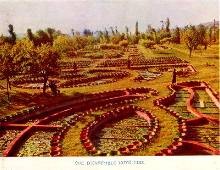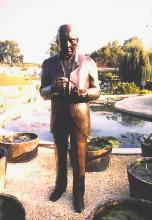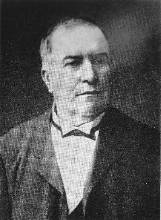 |
Latour-Marliac 1830-1911 |
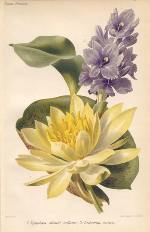 Image from Shigitatsu |
Joseph Bory Latour-Marliac was born March 6, 1830, in Granges-sur-Lot, Lot-et-Garonne, France, southeast of Bordeaux, where his family owned extensive properties. The family home was named Chateau le Rouge. His early education was in that region, in Toulon, and he then studied law in Paris. When his studies there were disrupted by the revolution of 1848, he returned home to supervise the family properties. In 1852, he married and settled in Le Temple-sur-Lot, two miles from his birthplace.
As were many members of his family, he was very interested in plants, and expressed it at an early age. When he returned home, he was able to give free rein to his passion. He built a large greenhouse on his property and filled it with tropical plants. Rare species of trees were planted in his garden.
Here begins confusing and conflicting information about Latour-Marliac's interest in aquatic plants. We have drawn heavily on the research of the late Father J.M. Berghs as well as his translations of old French texts, provided to him by Ray Davies and others, and published by Berghs in the Water Garden Journal from 1989 through 1993.
From Notes on the Horticultural Establishment Latour-Marliac (a text written by Latour-Marliac's successors): "An article on tropical water lilies, published in 1858 in a horticultural review, specially attracted Mr Bory Latour-Marliac's attention. After, for that time, a rather well documented, study, the author goes into raptures over the elegance and the rich colourings of those plants."
| From a typed document, Biographical note on Joseph Bory Latour-Marliac, Botanist - Officier d'Acadamie, found by Ray Davies among the Latour-Marliac papers: "Aquatic plants did not particularly hold his attention until one day in 1858 he read in a periodical of the Paris Jardin | ||
|
des Plantes, an article by Professor G Laveque, describing the nymphaeas coerulia - capensis -scutifolia - zanzibarensis - azurea and rosea, which recently had enriched the ponds of the Museum d'Histoire Naturelle. The author enthused about the rich colouring of their flowers and he regretted that those plants could not be acclimatised in the waters of our regions." No such article and no Professor Laveque have been found in the literature. The reference to the supposed author may have been to a nickname for Maurice Leveque de Vilmorin, who later wrote about Latour-Marliac's work in Revue horticole. It is clear from an article written by Latour-Marliac, "Notice sur les Nymphaea et Nelumbium rustiques", first published in the British horticultural periodical The Garden in 1887, that his inspiration for attempting to hybridize waterlilies was Charles Antoine Lemaire's article, "Nymphaea Devoniensis", which appeared in the Belgian publication Le Jardin Fleuriste in 1854. |
 Nymphaea Devoniensis (hybride) C. Lemaire Le Jardin Fleuriste Gand, chez les éditeurs et E. Gyselynck, 1851-1854 Image from Antiquariaat Junk |
|
Even though Latour-Marliac's essay wasn't published until 1887, it is entirely possible that he read the Lemaire article far earlier, possibly even knew Lemaire, based on the present tense used in this passage from the above mentioned article: "At present the learned author of these lines, Mr Ch. Lemaire, seems to be the happy owner, not only of a hothouse, but also of a similar dazzling prospect. An important revolution has taken place in the pretty aquatic plant world; the beautiful nymphs of the warm climate have discarded their disdainful chilly sternness, little compliant with their equatorial temperament; fertile alliances have been concluded with our elegant hardy water lilies and have given birth to multicoloured hybrids, gifted with an absolute robustness that does not fear the bleak northwinds nor prolonged stay under ice. And it should not be supposed that they are delicate with respect to their culture, the nature of the soil, the quality of the water, the kind of container, etc."
If Latour-Marliac read or knew Lemaire during that period, when Lemaire was in Ghent, Belgium, and associated with Louis Van Houtte, it is also quite possible that he read the article by French botanist Jules Emile Planchon, 'Ortgiesiano-rubra', published in Van Houtte's Flore des Serres et des jardins de l'Europe, Volume 8, 1852-1853 (French - English). This carefully documented article detailed the procedure for successfully cross-pollinating waterlilies. Latour-Marliac described the process himself in a paper read before the Royal Horticultural Society in 1898, extracts printed in The Garden in 1899.
From Summer Near Water and Marshes: "Joseph Bory Latour Marliac, inspired by Lemaire's article, as we have seen, did not only specialize in the hybridisation of water lilies. At the same time he was managing six family estates in an area of 5km around Le Temple. His first hybridisation of Nymphaeas were only made with a scientific aim and the commercial establishment Latour Marliac was set up by him only a long time later with a view to financing a bit of his research work."
|
The above quotation may be somewhat misleading. In an article in The Garden, December 23, 1893, Latour-Marliac wrote, "About the year 1879 I commenced the work in earnest . . ." He proceeded to describe his early efforts and results, including parentage of some hybrids. He was in possession of N. flava (today N. mexicana) which was the pollen parent for N. 'Marliacea Chromatella', N. 'Odorata Sulphurea' and N. 'Helvola'. In Summer Near Water and Marshes, we learn how Latour-Marliac obtained N. odorata var. rubra to use in his hybridizing. "The famous horticulturist Godefroy Leboeuf, from Argenteuil near Paris, however, attracted his attention to a red Nymphaea, which was then cultivated in Boston, USA. This horticulturist was so kind as to have a plant of that famous Nymphaea sent from America and this was the starting point of creating all the varieties, obtained since then. This is what Mr Godefroy-Leboeuf then wrote to M. Latour-Marliac: 'The Nymphaea odorata rubra is a plant that I received from America through the intermediary of the doyen of American horticulturists, Mr Hovey. He was here in 1878 and saw a flowering Nymphaea Caspary (today N. alba |
|
|||
| var. rubra) at my place. He told me that near Boston there was a variety with flowers of a such more brilliant pink, that those flowers were sold at a dollar apiece and that the monopoly was in the hands of one of his neighbours, who had never been willing to sell the plant. Mr Hovey asserted that on no account this neighbour would part with his goose that lays the golden eggs. I urged him to try the deal and put a thousand francs at his disposal. After a few months I received five or six plants as my share and Mr Hovey kept the rest.'" | ||||
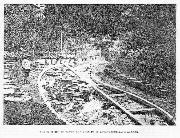 |
From Notes on the Horticultural Establishment Latour-Marliac: "Circa 1878, Godefroy-Leboeuf provided him with a plant of Odorata Rubra or Rosacea of the Americans, a unique specimen in Europe at that time. Van Nocett supplied him with Sphaerocarpa (today N. alba var. rubra) and from Kew Gardens he got seeds of tropical Nymphaeas. < Latour-Marliac's garden, From The Garden, February 9, 1901 |
|
|
|
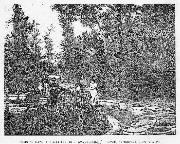 |
|
|
Though we don't know exactly when Latour-Marliac hybridized and selected N. 'Marliacea Chromatella', we do know that he sent a plant of it to the Royal Gardens at Kew in 1887. (See Canary Water Lily) By 1891, he had introduced a number of new hybrids, described in Les Nymphaea Rustiques (French - English) by Maurice-L. Vilmorin in Revue horticole. Latour-Marliac's garden, From The Garden, February 9, 1901 > |
||
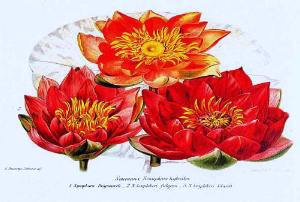 Nouveaux Nymphaea hybrides Revue Horticole 1895 © photo Association Edouard André |
In his paper Hardy Hybrid Water Lilies (The Garden 1899), Latour-Marliac himself described 34 "quite distinct varieties" with the promise of more to come. Today we attribute more than 110 cultivars to him, some released after his death. Though some references have suggested that he was secretive about his methods, there is much written evidence to the contrary. He was quite open about his methods and hoped to encourage others to undertake the hybridization of waterlilies. It does seem that he and his successors were careful to release only sterile hybrids. Some sources say this was for commercial reasons, though he wrote in The Garden in 1893 that at least one hybrid could not be sent out as "its seedlings could not be relied upon to resemble it". | |
References:
Berghs, Father J.M. Articles in Water Garden Journal, 1989-1993.
Conard, Henry S. The Waterlilies, A Monograph of the Genus Nymphaea, Chapter VII. The Carnegie Institution of Washington, 1905.
Latour-Marliac, J.B. HARDY HYBRID WATER LILIES. THE GARDEN, March 18. 1899.
Extract from a paper read before the Royal Horticultural Society, August 9, 1898.Planchon, Jules Emile. 'Ortgiesiano-rubra', Flore des Serres et des jardins de l'Europe, Volume 8, 1852-1853 (French - English)
Robinson, William. 1887, . Canary Water Lily. THE GARDEN, July 23, 1887.
Robinson, William & Latour-Marliac, B. The New Hardy Waterlilies. The Garden, December 23, 1893
Vilmorin, Maurice-L. LES NYMPHAEA RUSTIQUES - French (THE HARDY WATERLILIES - English) Revue horticole 1891
Notes on the Horticultural Establishment Latour-Marliac, undated, translated by Father J.M. Berghs.
Obituary. B. Latour-Marliac. The Gardeners' Chronicle, 1911, p.271
Summer Near Water and Marshes, undated, translated by Father J.M. Berghs.
|
|
|
|
|
|
|
|
|
